Vibrational Dynamics of Rice Precision Hole Seeders and Their Impact on Seed Dispensation Efficacy
Abstract
:1. Introduction
2. Seeder Structure and Working Principle
3. Seeder Vibration Characteristics Testing and Analysis
3.1. Equipment
3.2. Test Conditions and Methods
3.3. Analysis of Vibration Characteristics
3.3.1. Time-Domain Characteristic Analysis
3.3.2. Frequency Domain Characteristic Analysis
4. Bench Tests on the Effect of Seeder Performance
4.1. Test Conditions and Methods
4.2. Analysis of Test Results
5. Conclusions
Author Contributions
Funding
Institutional Review Board Statement
Data Availability Statement
Acknowledgments
Conflicts of Interest
References
- Luo, X.W.; Liao, j.; Hu, L.; Zang, Y.; Zhou, Z. Improving agricultural mechanization level to promote agricultural sustainable development. Trans. Chin. Soc. Agric. Eng. 2016, 32, 1–11. [Google Scholar]
- Mahajan, G.; Chauhan, B.S.; Gill, M.S. Dry-seededrice culture in Punjab State of India: Lessons learned from farmers. Field Crops Res. 2013, 144, 89–99. [Google Scholar] [CrossRef]
- Kumar, V.; Ladha, J.K. Direct seeding of rice: Recent developments and future research needs. Adv. Agron. 2011, 111, 297–413. [Google Scholar]
- Yang, L.; Yan, B.X.; Zhang, D.X. Research progress on precision planting technology of maize. Trans. Chin. Soc. Agric. Mach. 2016, 47, 38–48. [Google Scholar]
- Mishra, A.K.; Khanal, A.R.; Pede, V.O. Is direct seeded rice a boon for economic performance? Empirical evidence from India. Food Policy 2017, 73, 10–18. [Google Scholar] [CrossRef]
- Luo, X.W.; Wang, Z.M.; Zeng, S. Recent advances in mechanized direct seeding technology for rice. J. South China Agric. Univ. 2019, 40, 1–13. [Google Scholar]
- Rao, A.N.; Brainard, D.C.; Kumar, V.; Ladha, J.K.; Johnson, D.E. Preventive weed management in direct-seeded rice: Targeting the weed seedbank. Adv. Agron. 2017, 144, 45–142. [Google Scholar]
- Bhushan, L.; Ladha, J.K.; Gupta, R.K.; Singh, S.; Saharawat, Y.; Gathala, M.; Pathak, H.; Tirol-Padre, A. Saving of water and labor in a rice-wheat system with no-tillage and direct seeding technologies. Agron. J. 2007, 99, 1288–1296. [Google Scholar] [CrossRef]
- Weerakoon, W.M.W.; Mutunayake, M.M.P.; Bandara, C.; Rao, A.; Bhandari, D.; Ladha, J. Direct-seeded rice culture in Sri Lanka:Lessons from farmers. Field Crops Res. 2011, 121, 53–63. [Google Scholar] [CrossRef]
- Pandey, S.; Mortimer, M.; Wade, L.; Tuong, T.P.; Lopez, K.; Hardy, B. Direct Seeding: Research Issues and Opportunities; International Rice Research Institute (IRRI): Los Banos, Philippines, 2002; pp. 3–14. [Google Scholar]
- Pandey, S.; Velasco, L. Rice Is Life: Scientific Perspectives for the 2lst Century; Copyright International Rice Research Institute: Tsukuba, Japan, 2005; pp. 178–181. [Google Scholar]
- Zheng, G.J.; Tao, Y.; Shen, X.L.; Ye, C.; Xu, Y.; Chu, G.; Xu, C.; Wang, D. Study on Rice Seed Germination and Seedling Emergence and Related Problems in Direct Seeding Production. China Rice 2023, 29, 49–55. [Google Scholar]
- Chen, X.F.; Tang, Y.P.; Xie, Y.J.; Li, S.; Chu, J.; Ao, F.; Peng, W.; Li, H.S.; Wan, Y. Research Advances of Rice Mechanical Direct-seeding Technology in China. China Rice 2018, 24, 9–15. [Google Scholar]
- Wang, Z.M.; Pei, J.; He, J. Development of the sowing rate monitoring system for precision rice hill-drop drilling machine. Trans. Chin. Soc. Agric. Eng. 2020, 36, 9–16. [Google Scholar]
- Yang, Y.P. Design and Experimental Research on Seeder of Rice Dry Field Direct Seeding Planter; Qingdao University of Technology: Qingdao, China, 2021. [Google Scholar]
- Wang, Z.M. Research and Experiment on Key Technology of Rice Direct Seeding Machine Rice Direct Seeding Machine; Hubei University of Technology: Wuhan, China, 2020. [Google Scholar]
- Liao, Y.T.; Qi, T.X.; Liao, Q.X.; Zeng, R.; Li, C.L.; Gao, L.P. Vibration characteristics of pneumatic combined precision rapeseed seeder and its effect on seeding performance. J. Jilin Univ. (Eng. Technol. Ed.) 2022, 52, 1184–1196. [Google Scholar]
- Wang, Q.; Zhu, L.T.; Li, M.W.; Huang, D.Y.; Jia, H.L.; Zhuang, J. Vibration characteristics of corn no-tillage finger-type precision planter and its effect on seeding performance. Trans. Chin. Soc. Agric. Eng. 2019, 35, 9–18. [Google Scholar]
- Gu, L.C.; Guo, L.; Li, H. Analysis of the vibration characteristics of three-point-hanging shovel type wheat planter frame. Jiangsu Agric. Sci. 2017, 45, 214–216. [Google Scholar]
- Xu, L.Z.; Li, Y.M.; Sun, P.P. Vibration measurement and analysis of tracked-whole feeding rice combineharvester. Trans. Chin. Soc. Agric. Eng. 2014, 30, 49–55. [Google Scholar]
- Far, J.J.; Upadhyaya, S.K. Development and field evaluation of a hydropneumatic planter for primed vegetable seeds. Trans. ASAE 1994, 37, 1069–1072. [Google Scholar]
- Mf, K.; Lan, Y.; Chen, C.; Smith, J.A. Opto-electronic sensor system for rapid evaluation of planter seed spacing uniformityly. Trans. ASAE 1998, 41, 237–245. [Google Scholar]
- Niyamapa, T.; Salokhe, V.M. Force and pressure distribution under vibratory tillage tool. J. Terramechanics 2000, 37, 139–150. [Google Scholar] [CrossRef]
- Vu, L.; Zhang, X.; Walton, O.R. A 3-D discrete-element method for dry granular flows of ellipsoidal particles. Comput. Methods Appl. Mech. Eng. 2000, 187, 483–528. [Google Scholar]
- Min, Y.B.; Kim, S.T.; Kwon, H.D.; Moon, S.W.; Kang, D.H. Effect of the seed hopper vibration on the seeding performance of the vacuum suction nozzle seeder. J. Biosyst. Eng. 2008, 33, 179–185. [Google Scholar]
- Yu, D.Y.; He, J.F.; Peng, F.H.; Qian, C.; Zang, Y.; Zhang, M.; Yang, W.; Zeng, G.; Chen, J.; Qin, W.; et al. Study on Vibration Characteristics of Paddy Power Chassis under Different Driving Conditions. Agriculture 2023, 13, 1842. [Google Scholar] [CrossRef]
- Gao, Z.P.; Xu, L.Z.; Li, Y.M.; Wang, Y.; Sun, P. Vibration measure and analysis of crawlertype rice and wheat combine harvester in field harvesting condition. Trans. CSAE 2017, 33, 48–55. [Google Scholar]
- Xi, X.B.; Gao, W.J.; Gu, C.J.; Shi, Y.; Han, L.; Zhang, Y.; Zhang, B.; Zhang, R. Optimisation of no-tube seeding and its application in rice planting. Biosyst. Eng. 2021, 210, 115–128. [Google Scholar] [CrossRef]
- Zhao, J.; Xi, X.B.; Shi, Y.J.; Zhang, B.; Qu, J.; Zhang, Y.; Zhu, Z.; Zhang, R. An Online Method for Detecting Seeding Performance Based on Improved YOLOv5s Model. Agronomy 2023, 13, 2391. [Google Scholar] [CrossRef]
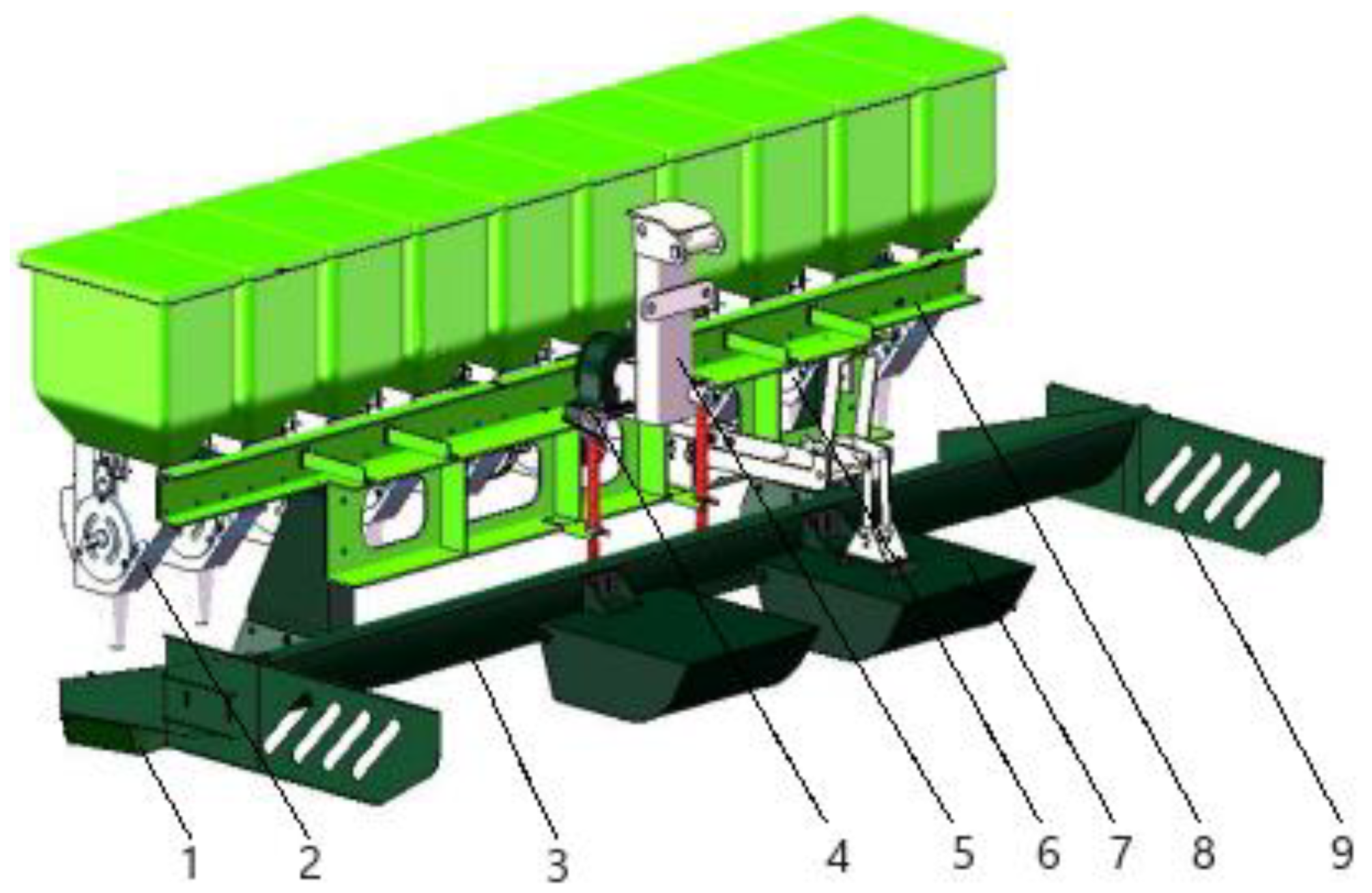

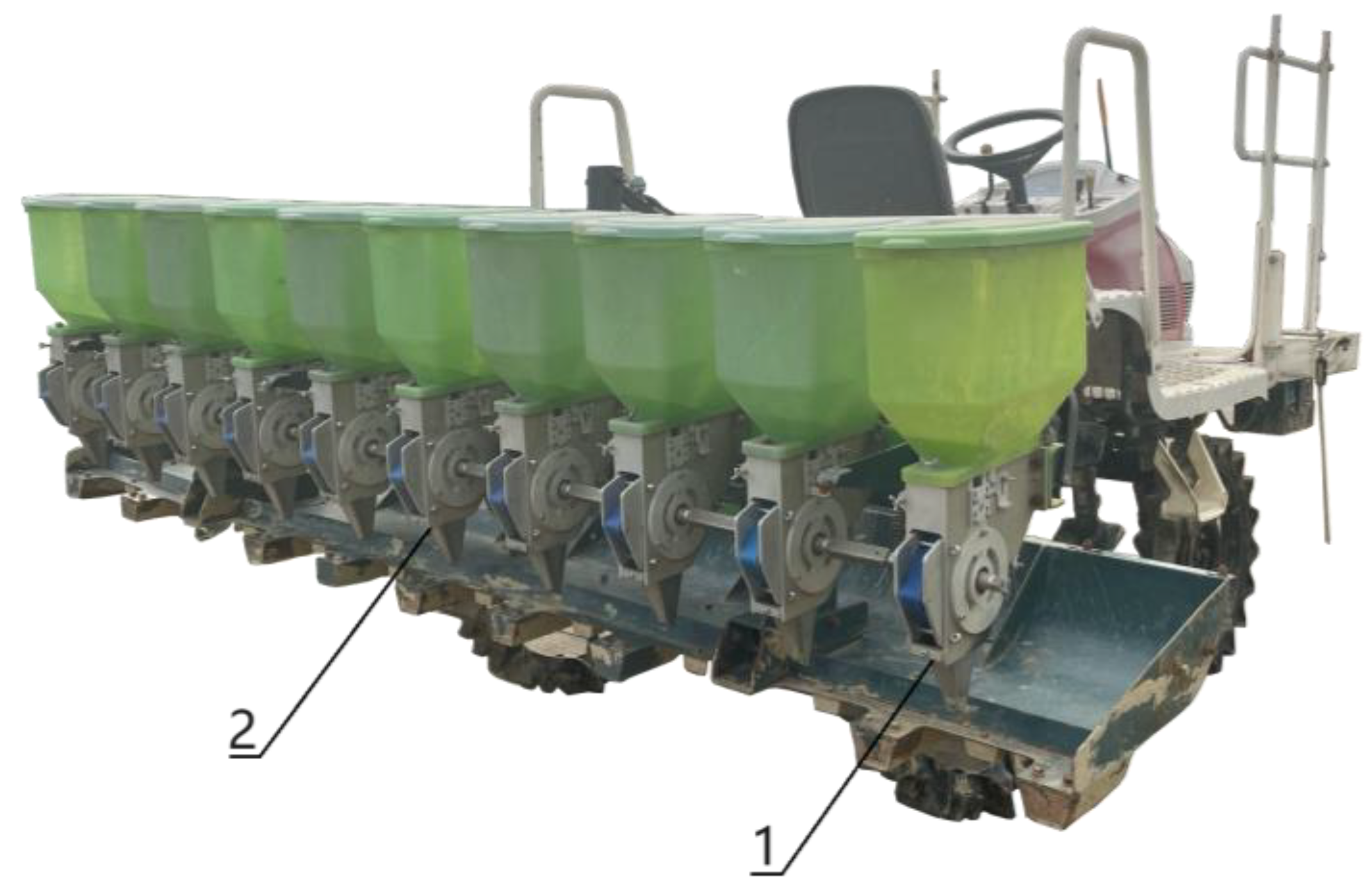


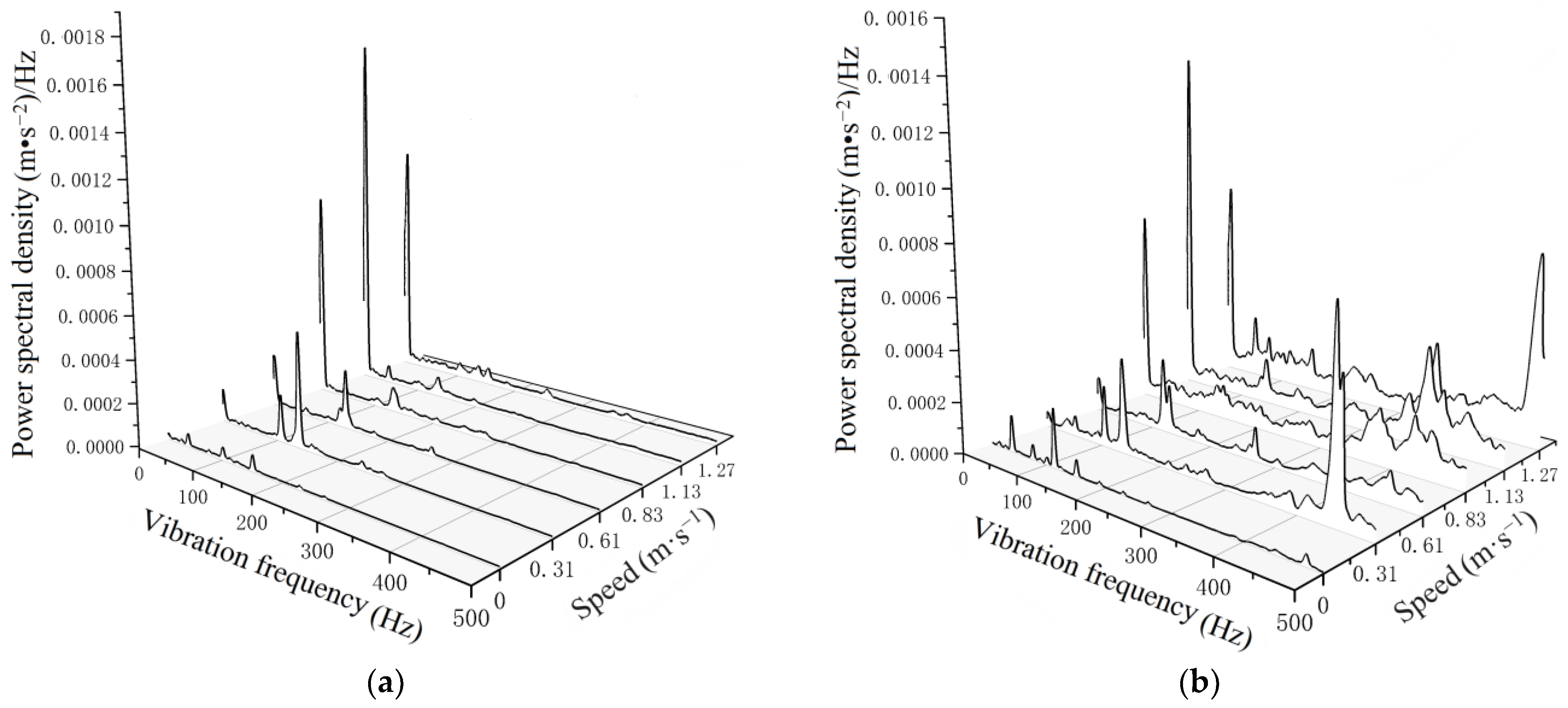
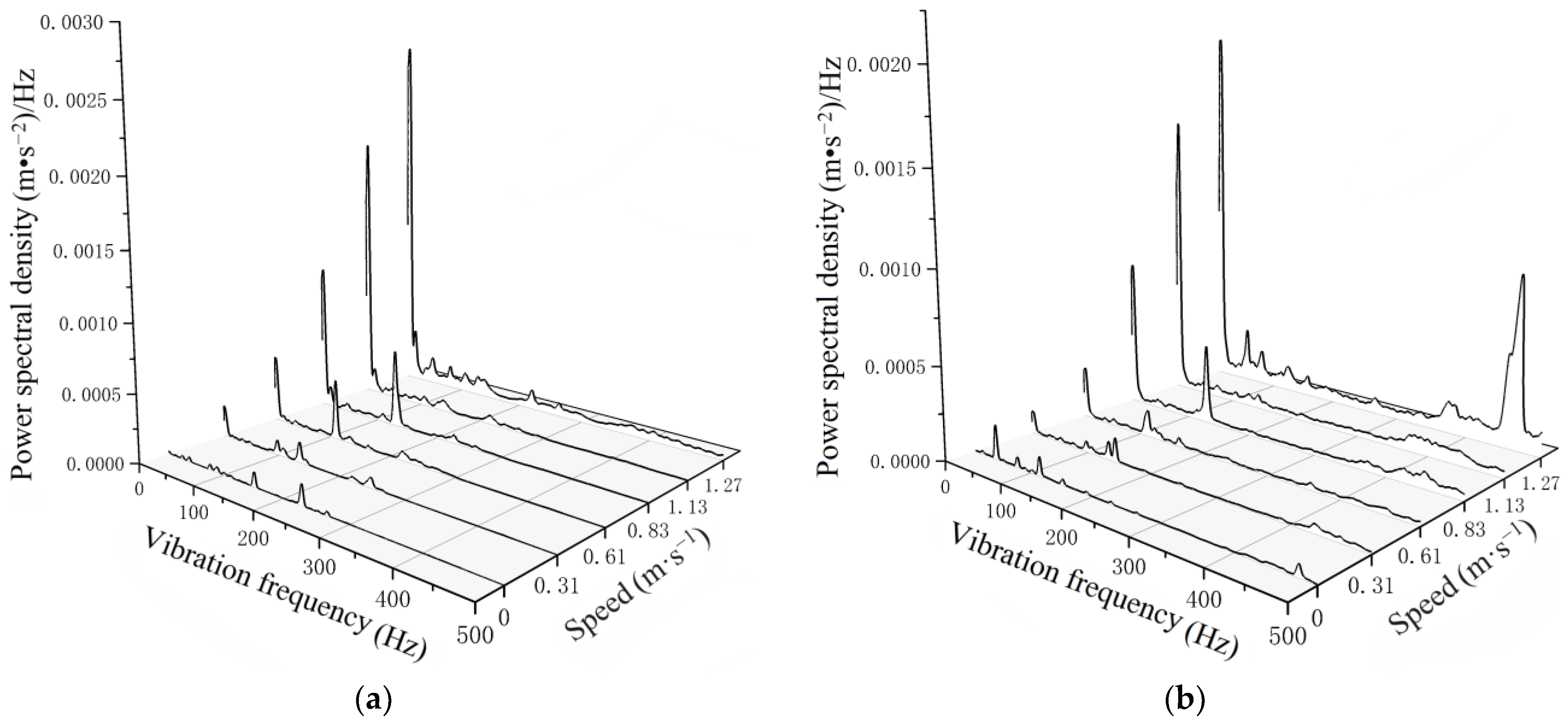
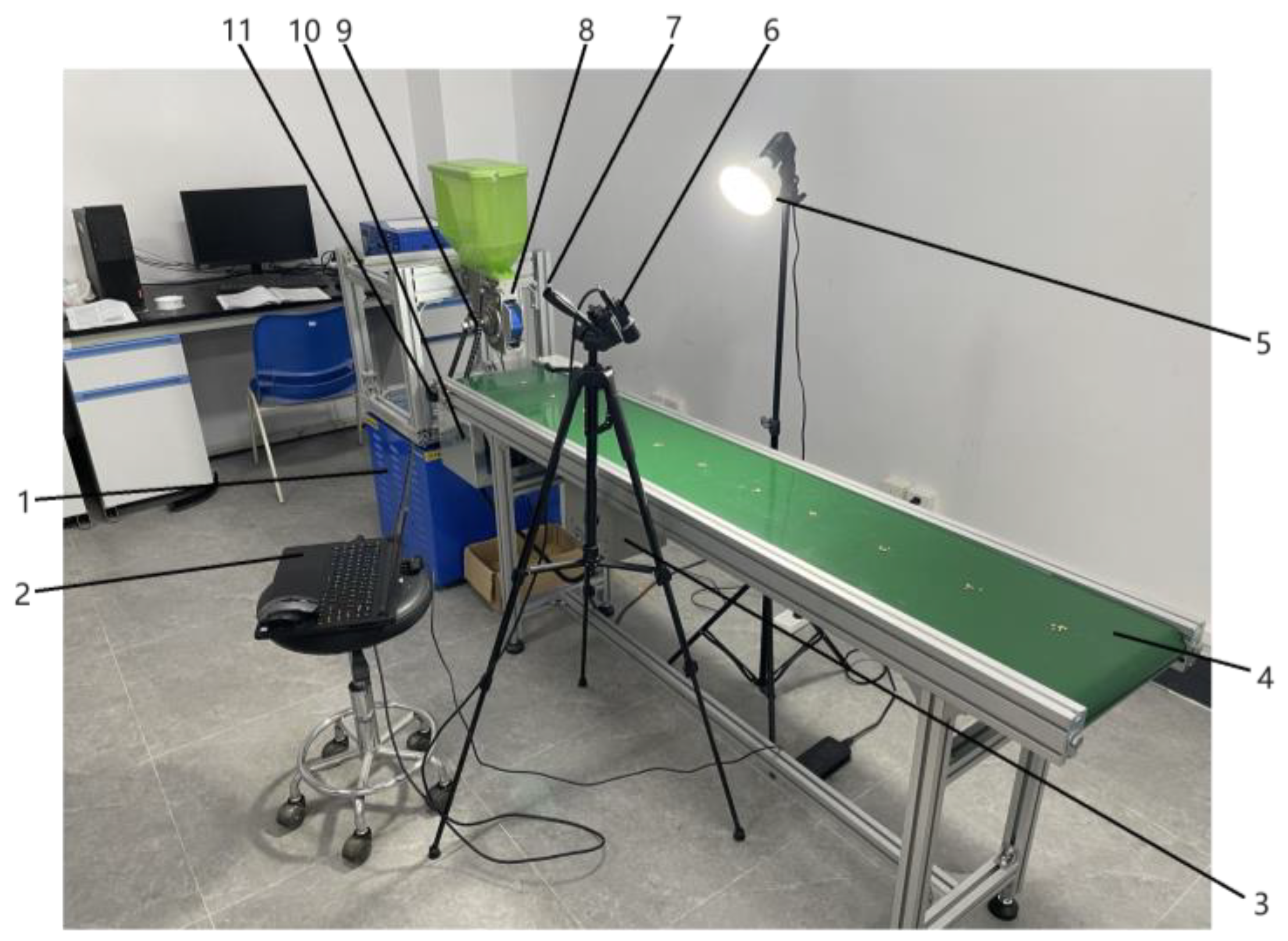
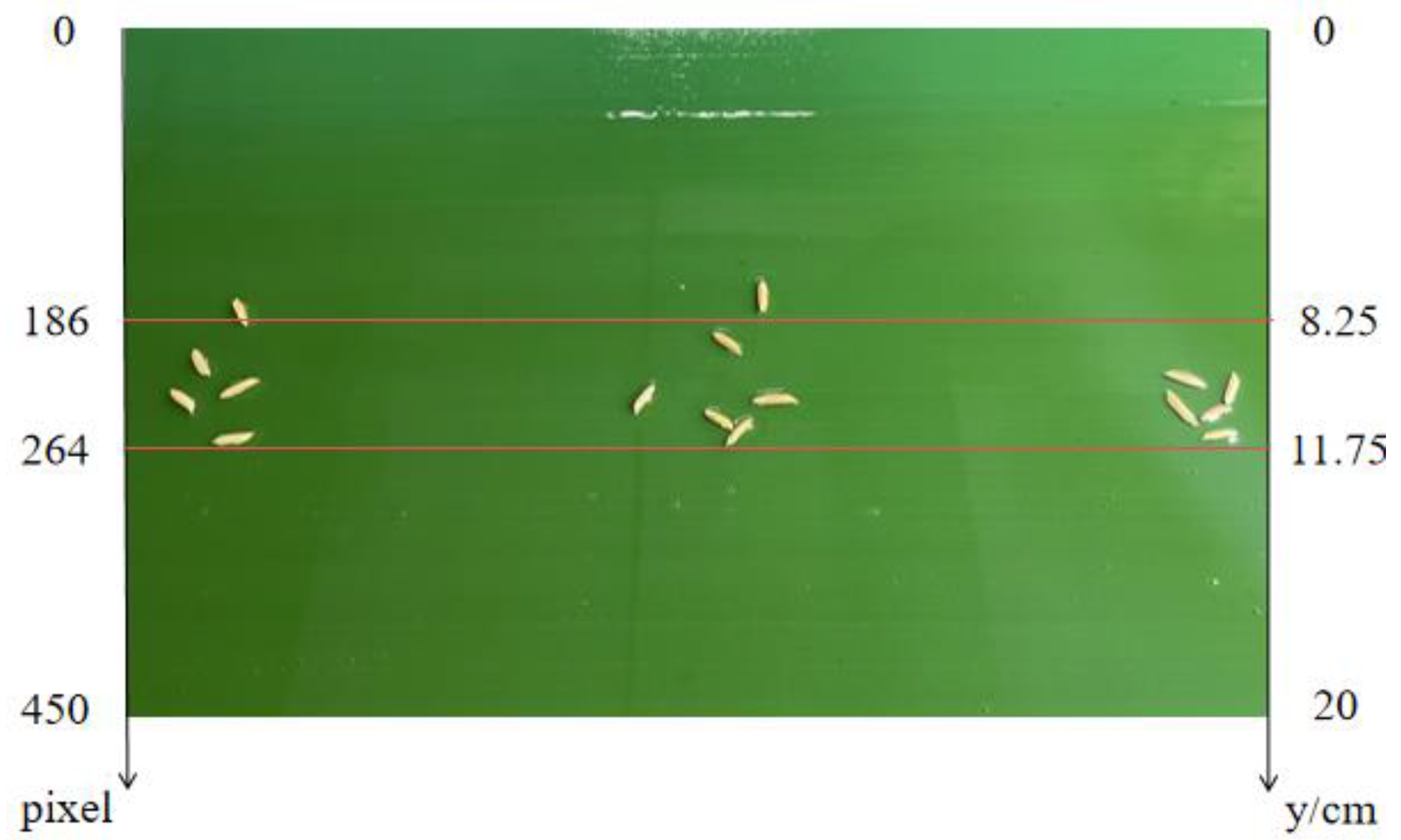



| Device Name | Items | Parameter Value |
|---|---|---|
| Yanmar VPG6G rice transplanter power chassis | Power Chassis Weight (ma, kg) | 720 |
| Operating speed (v, km·h−1) | 0~5.3 | |
| Rated engine power (P, kW) | 10.3 | |
| Wheelbases (L, mm) | 1050 | |
| Front wheelbase (lr, mm) | 1220 | |
| Rear wheelbase (lf, mm) | 1200 | |
| 2BDXZ-10CP(20) rice precision hole seeder | Seeder size (L × W × H, mm) | 1050 × 2080 × 500 |
| Seeder weight (mb, kg) | 185 | |
| Working width (mm) | 2000 | |
| Number of rows sown | 10 | |
| Row spacing (cm) | 20 | |
| Distance between holes (cm) | 10~20 adjustable | |
| Seeding rate (kg·hm−2) | 22.5~75 (3~10 grain/cavity adjustable) |
| Device Name | Items | Parameter Value |
|---|---|---|
| CT1010SLFP Piezoelectric Triaxial Acceleration Sensor | Range (g) | ±50 |
| Frequency response (Hz) | 0.5~8000 | |
| Degree of sensitivity (mV·g−1) | 100 | |
| Lateral sensitivity (%) | <5 | |
| USB-1608G Multi-function Data Acquisition Instrument | Channel number | 16 |
| Maximum sampling rate (kS·s−1) | 500 | |
| Distortion (%) | <0.5 |
| Field Type | Items | Parameter Value |
|---|---|---|
| Clay loam field | Soil moisture content of the subsoil (%) | 37.6 |
| Soil cohesion (kPa) | 2.83 | |
| Permissible soil weight (g·cm−3) | 1.81 | |
| Sandy loam field | Soil moisture content of the subsoil (%) | 31.3 |
| Soil cohesion (kPa) | 2.56 | |
| Permissible soil weight (g·cm−3) | 1.75 |
| First Row of Seeders | Fifth Row of Seeders | ||||||
|---|---|---|---|---|---|---|---|
| First Order Frequency (Hz) | Second Order Frequency (Hz) | Third Order Frequency (Hz) | First Order Frequency (Hz) | Second Order Frequency (Hz) | Third Order Frequency (Hz) | ||
| Clay loam field | 0 m·s−1 | 12.73 | 152.6 | 38.18 | 114.2 | 8.18 | 76.29 |
| 0.31 m·s−1 | 3.73 | 136.7 | 34.33 | 106.1 | 3.73 | 52.98 | |
| 0.61 m·s−1 | 2.51 | 131.2 | 59.66 | 119.3 | 2.525 | 48.62 | |
| 0.83 m·s−1 | 4.3 | 132.8 | 46.65 | 131.7 | 3.273 | 45.58 | |
| 1.13 m·s−1 | 4.13 | 135.1 | 46.07 | 139.4 | 4.57 | 46.34 | |
| 1.27 m·s−1 | 5.32 | 155.5 | 77.85 | 155.5 | 4.715 | 52.2 | |
| Sandy loam field | 0 m·s−1 | 12.76 | 153.1 | 38.27 | 114.8 | 12.87 | 76.57 |
| 0.31 m·s−1 | 4.28 | 136.3 | 32.52 | 146.4 | 3.46 | 51.21 | |
| 0.61 m·s−1 | 4.07 | 109.8 | 24.13 | 113.9 | 2.52 | 54.96 | |
| 0.83 m·s−1 | 3.87 | 130.3 | 46.07 | 130.4 | 2.6 | 47.47 | |
| 1.13 m·s−1 | 4.33 | 139.3 | 34.3 | 142.6 | 3.82 | 50.27 | |
| 1.27 m·s−1 | 5.58 | 128.6 | 46.3 | 128.5 | 2.35 | 52.35 | |
| Equipment Name | Item | Parameter |
|---|---|---|
| Conveyor belts | Conveyor belt (L × W, cm) | 300 × 30 |
| Conveyor belt material | PVC | |
| Conveyer speed (m·s−1) | 0~1.3 | |
| Image acquisition camera | Camera model | AF16V20 |
| Pixel | 16 million | |
| Resolution | 4656 × 3496 | |
| Focusing method | Automatic | |
| Zooming | Autofocus | |
| Angle | Wide Angle 95°, Viewing Angle 65° | |
| Six-degree spatial vibration tester | Model | HD-G809-5 |
| Direction of vibration | Triaxial vibration | |
| Size (L × W × H, mm) | 500 × 550 × 500 | |
| Weight-bearing capacity (kg) | 0~100 | |
| Acceleration interval (g) | 0~15 | |
| Sweep Range (Hz) | 0.5~600 | |
| Vibration waveform | Sine wave |
Disclaimer/Publisher’s Note: The statements, opinions and data contained in all publications are solely those of the individual author(s) and contributor(s) and not of MDPI and/or the editor(s). MDPI and/or the editor(s) disclaim responsibility for any injury to people or property resulting from any ideas, methods, instructions or products referred to in the content. |
© 2024 by the authors. Licensee MDPI, Basel, Switzerland. This article is an open access article distributed under the terms and conditions of the Creative Commons Attribution (CC BY) license (https://creativecommons.org/licenses/by/4.0/).
Share and Cite
Yu, D.; Peng, F.; Zeng, Z.; Zhang, M.; Yang, W.; Zang, Y.; He, J.; Huang, Y.; Wu, Y.; Zhong, W.; et al. Vibrational Dynamics of Rice Precision Hole Seeders and Their Impact on Seed Dispensation Efficacy. Agriculture 2024, 14, 324. https://doi.org/10.3390/agriculture14020324
Yu D, Peng F, Zeng Z, Zhang M, Yang W, Zang Y, He J, Huang Y, Wu Y, Zhong W, et al. Vibrational Dynamics of Rice Precision Hole Seeders and Their Impact on Seed Dispensation Efficacy. Agriculture. 2024; 14(2):324. https://doi.org/10.3390/agriculture14020324
Chicago/Turabian StyleYu, Dongyang, Feihu Peng, Zhihao Zeng, Minghua Zhang, Wenwu Yang, Ying Zang, Jianfei He, Yichen Huang, Yuguang Wu, Wenneng Zhong, and et al. 2024. "Vibrational Dynamics of Rice Precision Hole Seeders and Their Impact on Seed Dispensation Efficacy" Agriculture 14, no. 2: 324. https://doi.org/10.3390/agriculture14020324





